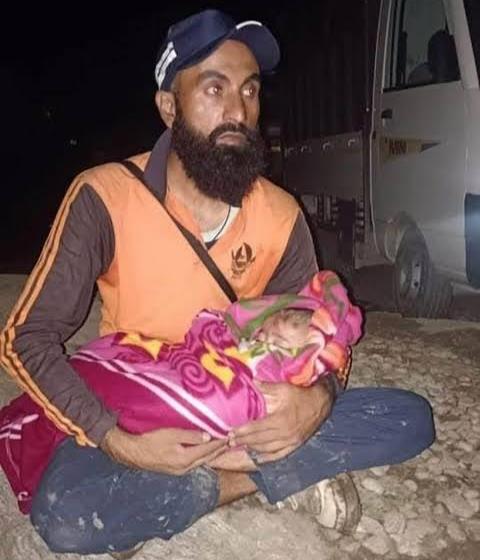
A Child In His Arms: The Image That Defined Kishtwar's Rescue
Shahnawaz with the baby
By Sadaket Ali Malik
Srinagar- Shahnawaz still remembers the weight of the child in his arms. The night was cold, the air smelled of mud and floodwater, and the cries around him mixed with the roar of the mountain stream gone wild.
He had waded into the torrent as part of the State Disaster Response Force (SDRF), searching for survivors after a sudden cloudburst ripped through Chasoti village in Kishtwar's Padder area on August 14.
Amid the wreckage, he found the boy, drenched and alone. The parents were missing. Shahnawaz lifted him, pressed him close, and kept walking.
That night, as India prepared to mark Independence Day, Kishtwar was drowning. A burst of rain from the skies above had turned into a furious flood, sweeping through homes, camps, and the crowded paths of the Machail Mata Yatra.
Read Also PM Modi Very Concerned, Monitoring Situation In Cloudburst-Hit Kishtwar: Rajnath Def Minister Reaching Jammu To Meet Cloudburst Victims: LGBy dawn, roads had been washed away, bridges torn apart, and dozens of families were stranded. The Chenab Valley, known more for its difficult terrain than for headlines, was suddenly a place of tragedy.
Jammu and Kashmir is no stranger to such fury. Between 2010 and 2022, the region reported more than 50 major incidents of cloudbursts and flash floods, according to government data. In August alone, this fragile Himalayan belt has witnessed repeated calamities, from Ganderbal to Kargil.
Chasoti became the latest reminder of how entire communities live at the mercy of changing weather, steep slopes, and a warming climate that intensifies sudden downpours.
Kishtwar Tragedy Was Years in the Making
The first to respond were soldiers. The 17 Rashtriya Rifles moved before midnight, joined by local police. Over 300 personnel, including doctors and engineers, were on the ground within hours. They carried stretchers across broken tracks, laid temporary planks where bridges had collapsed, and cleared debris with bare hands.
Survivors recall the sight of soldiers handing out water bottles and biscuits to frightened children.
Alongside them came others. Seven ambulances of Ababeel, an NGO founded in 2015 in Kishtwar, maneuvered into the valley before sunrise.
Volunteers distributed food kits, blankets, and medicines, often hiking through slippery paths where vehicles could not go. The group's founder, Advocate Hassan Babur Nehru, describes their work as“answering a moral call.”
In a place where caste and religion often divide, Ababeel's relief work has long carried a message: in crisis, humanity stands above all.
The official machinery, too, did not remain distant. Among the faces villagers remember is ARTO Kishtwar, Tasleem Wani. Instead of sitting in his office, Wani spent days on the ground, personally guiding yatris to buses and helping families find transport out of the disaster zone.
One viral photograph showed him seated by the roadside with a steel plate of rice, a rare break in days of nonstop work. To locals, that image became proof that the administration was walking with them, not standing apart.
Chasoti's people did not wait for help either. Young men from nearby hamlets dug with their hands, searching for missing neighbours. Women opened their kitchens to cook for stranded yatris. In the face of destruction, the valley's oldest survival code came alive: collective resilience.
By the second day, rescue teams from the National Disaster Response Force (NDRF) joined operations. Helicopters ferried the injured to hospitals, while volunteers kept the ground supplied with essentials.
Yet the losses were heavy. Several villagers remained missing, their names scribbled on lists pinned outside relief camps. Children clung to strangers. Old men stared at the broken lines where houses once stood.
Photo Credits: Social Media
For many in Kashmir, the Chasoti disaster was a haunting echo of earlier floods: 2014 in Srinagar, 2021 in Kishtwar, and countless smaller cloudbursts in the high reaches.
Each time, it is local networks of rescue workers, NGOs, and ordinary residents that form the backbone of response.
Scientists at Kashmir University have long warned that the Chenab and Lidder valleys, with their fragile geology and thinning glaciers, are especially vulnerable to sudden cloudbursts. Yet preventive planning and rehabilitation remain slow, leaving communities exposed.
Still, what lingers from Chasoti is not only destruction but also memory of collective, community courage. It showed that in Kashmir's most fragile spaces, humanity can be stronger than any flood.
For Shahnawaz, the SDRF worker, the image of him holding that child became a symbol of the night.
He does not think of it as heroism.“It was only duty,” he says, adjusting his cap as he prepares for another field assignment.
Yet for those who watched him carry a life across the waters, it was more than duty.
It was the embrace of humanity in the valley's darkest hour.

Legal Disclaimer:
MENAFN provides the
information “as is” without warranty of any kind. We do not accept
any responsibility or liability for the accuracy, content, images,
videos, licenses, completeness, legality, or reliability of the information
contained in this article. If you have any complaints or copyright
issues related to this article, kindly contact the provider above.


















Comments
No comment